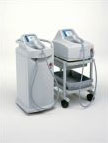Overview
Laser hair removal is an effective and gentle way of eliminating unwanted hair. The result is beautiful soft skin that doesn’t require daily shaving or frequent depilation.
RomiTal offers laser hair removal performed by experienced, well-trained staff using safe and reliable diode laser system LightSheer™ (Figure 1) from Coherent Inc., the worlds’ largest manufacturer of lasers. The procedure is approved by the FDA for both men and women and requires no anesthesia. According to Coherent’s president and CEO Bernard Couillaud, Coherent is “excited to be able to offer the first FDA-cleared diode laser system for hair removal, and we are equally excited about LightSheer’s market potential, both in the United States and abroad.”
Today laser technology advances allow gentle removal of unnecessary hair with the help of light. Diode laser safely and effectively removes persistent and irksome hair from face, back, legs, bikini area or any other body part. For millions of men and women who suffer from unnecessary hair it sounds like a dream come true.
About lasers
Diode laser is a device for noninvasive light therapy created specially for removal of unwanted hair on all parts of the body.
Diode laser is the most advanced generation of laser devices for hair removal. Earlier lasers used such light sources as ruby and alexandrite and had many limitations that diode lasers do not have. Previous generations of lasers for hair removal were less selective and less effective.
Results of clinical trials prove that effectiveness of diode laser is several times higher than that of earlier laser types. It means that fewer procedures are required for hair removal, treatment is more comfortable, and hair re-growth takes longer.
Diode laser is the only type of laser that is permitted to use on suntanned skin! However it is better to avoid sun tanning before the procedure for better results.
How lasers work
Laser hair removal is based on selective photothermolysis theory. Diode laser uses monochromatic light to remove hair and reduce its growth. Laser light flashes penetrate the skin up to strictly defined depth and damage hair follicles. Diode laser can eliminate hair of any thickness, color or density, except for lanugo, very light or grey hair.
During the procedure the doctor presses the hand-held laser (Figure 2) to your skin (Figure 3) and activates it for a fraction of a second. The laser light passes through the skin (Figure 4). It targets melanin present in hair body and in the upper third of follicular epithelium.
Warmth of the heated hair body is distributed in the tissue of hair follicle, damages its functions and impairs its ability to fabricate hair.
General scheme for laser hair removal
- Wavelength selection
- Longer waves penetrate deeper providing more effective hair heating (typical depth is 2-6 mm).Ideal wavelength is in the range of 750-800 nm.
- Effective spot size and energy density
- Laser radiation begins to scatter when entering the tissues so the spot must be reasonably big to reach high energy on follicle. Wellman Laboratories studies proved that the spot size less than 7 mm gives minimum energy at the depth of follicle bedding.Necessary energy density for the effect of hair removal permanency can be reached only with large spot sizes.
- Cooling
-
Optimal epidermis protection is achieved only with systems that provide skin cooling before, during and after laser light impulse passing. Wellman Laboratories studies proved that cooling systems provide 4-5 times better epidermis protection during the whole impulse cycle than simple prior cooling. LightSheerTM system has a convenient sapphire cooling tip
ChillTip™ (Figure 5). - Compression
-
Oxyhemoglobin is a competing chromofore in laser hair removal therefore compression provides blood expulsion from vessels, making passage of radiation to follicle easier. Compression also draws the follicle closer to surface making the procedure more effective (Figure 6).
- Impulse duration selection
- Radiation impulse duration must be smaller than target thermorelaxation time to minimize thermal damage of adjacent tissues. Studies have proved that for the hair range subject to depilation impulse duration should be in the range of 10-100 ms. Shorter impulses do not provide as long-lasting effect of laser depilation. Possibility of changing the radiation impulse duration is necessary for removal of hair of various diameters and work with skin of different types.
- Thus an ideal hair removal laser system should have the following main features:
-
- Appropriate wavelength (750-800 nm)
- Large spot size (7-12 mm) with high radiation energy density in it (not less than 40 J/cm2)
- Impulse duration from 10 to 400 ms
- Contact cooling before, during and after radiation impulse
- Compression
Cautions and limitations
As the principle of laser hair removal is in laser action on dark pigment that is contained in hair, the procedure cannot remove lanugo hair or light hair that does not contain pigment as well as grey hair.
If you have psoriasis or vitiligo, you should be warned about the possibility of causing more lesions in the treated areas.
If you have an active bacterial or viral infection, the treatment should be postponed until the condition resolves.
A history of hypertrophic scarring or keloid formation requires less aggressive laser treatments in order to avoid any complications.
Before hair removal
It is best to avoid sun tanning prior to laser hair removal. To reduce the risk of complications you should refrain from taking medications such as aspirin and other nonsteroidal anti-inflammatory drugs, or dietary supplements such as niacin and vitamin E. If you have a tan from sun exposure or sunless tanning products, you must wait until the tan fades completely before you can undergo laser hair removal, because a tan increases your risk of side effects such as blistering and discoloration.
Before the procedure the processed area must be cleanly shaven or cleaned with depilatory cream.
Note! Methods that hurt hair bulbs, like wax depilation and common epilators, should not be used! It is prohibited to sunbathe during 2 weeks before the procedure.
What areas can be treated?
Laser hair removal can be performed on virtually any part of the body.
Women usually want hair to be removed from: upper lip, chin, eyebrows, sideburns, bikini line, legs and underarms.
Men commonly want the treatment on: back, chest, neck, shoulders and face.
The procedure
Laser hair removal is quick, safe and effective. During the procedure the skin is intensely cooled by sapphire laser head to reduce pain or discomfort. Some people may feel slight pinching, similar to being snapped with a rubber band.
Duration of laser hair removal depends on the size of the treated skin area and varies from 10-15 minutes (upper lip or chin area) to 1.5-3 hours (complete legs).
Diode laser makes hair removal practically painless. Patient may feel light tingling in sensitive areas (armpits). Unpleasant sensations are possible in highly sensitive areas (bikini area), so patients are offered local anesthesia with anesthetic cream.
Usually laser hair removal does not cause any side effects. Some patients during the procedure may experience reddening in highly sensitive areas that disappears after several minutes or several hours, and temporary hypopigmentation or hyperpigmentation.
After the procedure
The procedure results in temporary absence of hair on the processed body area. As the laser damages only hair bulbs that are in the stage of active growth, it is necessary to repeat the procedure 4-6 times with an interval of 1.5-2 months.
In most cases laser hair removal does not requires special rehabilitation. It is not recommended to sunbathe during 7-10 days after the procedure. If hair was removed on exposed body areas, it is recommended to use sunscreen creams.
If you have more questions about laser hair removal, feel free to contact us.






